All Exams >
NEET >
Weekly Tests for NEET Preparation >
All Questions
All questions of April Week 2 for NEET Exam
Wind pollination is common in- a)Lilies
- b)Legumes
- c)Grasses
- d)Orchids
Correct answer is option 'C'. Can you explain this answer?
Wind pollination is common in
a)
Lilies
b)
Legumes
c)
Grasses
d)
Orchids
|
|
Vijay Bansal answered |
Grasses are wind-pollinated, and a single flower head of an average grass can produce ten million pollen grains! Any one of those only has a miniscule chance of landing on the stigma of one of is own kind, so while the pollen may be carried incredible distances, the majority of the grains tend to land within just a few metres of the plant. Therefore wind-pollinated plants usually grow closely together, to increase the likelihood of pollination.
When pollen is transferred from the anther of one flower to the stigma of another flower of the same plant, pollination is referred to:
- a)Geitonogamy
- b)Allogamy
- c)Xenogamy
- d)Siphonogamy
Correct answer is option 'A'. Can you explain this answer?
When pollen is transferred from the anther of one flower to the stigma of another flower of the same plant, pollination is referred to:
a)
Geitonogamy
b)
Allogamy
c)
Xenogamy
d)
Siphonogamy
|
|
Geetika Shah answered |
- In self-pollinating plants, there is less dependence on external factors to cause pollination.
- These plants depend on wind or other smaller insects that visit the flower regularly.
- In self- pollinating flowers, the anthers, and stigma are of similar lengths to facilitate the transfer of pollen.
Self -pollination can be further divided into two types:
- Autogamy– In this type of self-pollination, the pollen is transferred from the anthers of one flower to the stigma of the same flower.
- Geitonogamy– In this type of self- pollination, the anthers are transferred from the anthers of one flower to the stigma of another flower but on the same plant.
Self Pollination:
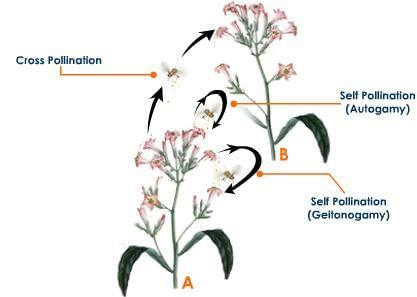

Hence, the correct option is A
NCERT Reference: Topic “Pollination” of chapter "Sexual Reproduction in Flowering Plants" of NCERT
In which one of the following is pollination autogamous?- a)Cleistogamy
- b)Geitonogamy
- c)Xenogamy
- d)Chasmogamy
Correct answer is 'A'. Can you explain this answer?
In which one of the following is pollination autogamous?
a)
Cleistogamy
b)
Geitonogamy
c)
Xenogamy
d)
Chasmogamy
|
|
Anjali Iyer answered |
Cleistogamy is autogamous pollinatin. When pollination and fertilization occur in unopened flower bud, it is known as cleistogamy. It ensures self-pollination and prevents cross-pollination.
The type of pollination that brings genetically different types of pollen grains to the stigma of a plant is- a)Geitonogamy
- b)Xenogamy
- c)Chasmogamy
- d)Autogamy
Correct answer is option 'B'. Can you explain this answer?
The type of pollination that brings genetically different types of pollen grains to the stigma of a plant is
a)
Geitonogamy
b)
Xenogamy
c)
Chasmogamy
d)
Autogamy
|
|
Rajat Kapoor answered |
Xenogamy : Only types of pollination which brings genetically different types of pollen grains to the stigma.
In some plants, the anthers and stigma grow and mature at the same time. This phenomenon is called- a)Syngamy
- b)Fusion
- c)Allogamy
- d)Homogamy
Correct answer is 'D'. Can you explain this answer?
In some plants, the anthers and stigma grow and mature at the same time. This phenomenon is called
a)
Syngamy
b)
Fusion
c)
Allogamy
d)
Homogamy
|
|
Vijay Bansal answered |
Homogamy is the condition in which male and female parts of a flower mature simultaneously.
Chiropterophily means- a)Pollination by bats
- b)Pollination by snails
- c)Pollination by insects
- d)Pollination by wind
Correct answer is option 'A'. Can you explain this answer?
Chiropterophily means
a)
Pollination by bats
b)
Pollination by snails
c)
Pollination by insects
d)
Pollination by wind
|
|
Pooja Mehta answered |
Bat pollination (chiropterophily) Bat-pollinated flowers tend to be large and showy, white or light coloured, open at night and have strong musty odours. They are often large and bell-shaped or a ball of stamens. Flowers are typically borne away from the trunk or other obstructions.
Four point charges are placed at the corners of a square ABCD of side 10 cm, as shown in figure. The force on a charge of 1μC placed at the centre of square is
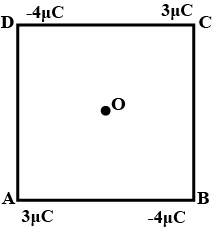
- a)7N
- b)8N
- c)2N
- d)zero
Correct answer is option 'D'. Can you explain this answer?
Four point charges are placed at the corners of a square ABCD of side 10 cm, as shown in figure. The force on a charge of 1μC placed at the centre of square is


a)
7N
b)
8N
c)
2N
d)
zero
|
|
Suresh Iyer answered |
Forces of repulsion on 1μC charge at O due to 3 μC charge, at A and C are equal and opposite. So they cancel each other.
Similarly, forces of attraction of 1μC charge at O due to -4μC charges at B and D are also equal and opposite. So they also cancel each other.
Hence the net force on the charge of 1μC at O is zero.
Similarly, forces of attraction of 1μC charge at O due to -4μC charges at B and D are also equal and opposite. So they also cancel each other.
Hence the net force on the charge of 1μC at O is zero.
How many grams of NaOH are present in 250 mL of 0.5 M NaOH solution?- a)7.32 g
- b)3.8 g
- c)5g
- d)0.5 g
Correct answer is option 'C'. Can you explain this answer?
How many grams of NaOH are present in 250 mL of 0.5 M NaOH solution?
a)
7.32 g
b)
3.8 g
c)
5g
d)
0.5 g
|
|
Anjali Sharma answered |
No. of moles of NaOH

Mass of NaOH = 40 × 0.125 = 5g

Mass of NaOH = 40 × 0.125 = 5g
How many Na+ ions are present in 100 mL of 0.25 M of NaCl solution?- a)0.025 × 1023
- b)1.505 × 1022
- c)15 × 1022
- d)2.5 × 1023
Correct answer is option 'B'. Can you explain this answer?
How many Na+ ions are present in 100 mL of 0.25 M of NaCl solution?
a)
0.025 × 1023
b)
1.505 × 1022
c)
15 × 1022
d)
2.5 × 1023
|
|
Mira Joshi answered |

NaCl → Na+ + Cl−
No. of moles of Na+ ions = 0.025
No. of Na+ ions = 0.025 x 6.023 x 1023 = 1.505 × 1022
What will be the mole fraction of ethanol in a sample of spirit containing 85% ethanol by mass?- a)0.69
- b)0.82
- c)0.85
- d)0.60
Correct answer is option 'A'. Can you explain this answer?
What will be the mole fraction of ethanol in a sample of spirit containing 85% ethanol by mass?
a)
0.69
b)
0.82
c)
0.85
d)
0.60
|
|
Meera Singh answered |

Mass of C2H5OH = 85 g
Molar mass of C2H5OH = 46 g/mol
nC2H5OH = 85/46 = 1.85 mol
Mass of water = 100 - 85 = 15 g
nH2O = 15/18 = 0.833 mol

The molality of 648 g of pure water is- a)36 m
- b)55.5 m
- c)3.6 m
- d)5.55 m
Correct answer is option 'B'. Can you explain this answer?
The molality of 648 g of pure water is
a)
36 m
b)
55.5 m
c)
3.6 m
d)
5.55 m
|
|
Jyoti Sengupta answered |
Molality = no of moles of solute/mass of solvent in kg
Molar mass of water = 18 g
Mass of water = 648 g
No of moles of water = 648/18 = 36 mol

Molar mass of water = 18 g
Mass of water = 648 g
No of moles of water = 648/18 = 36 mol

Choose the correct statement from the following:- a)Chasmogamous flowers never exhibit autogamy
- b)Chasmogamous flowers always exhibit geitonogamy
- c)Cleistogamous flowers exhibit both autogamy and geitonogamy
- d)Cleistogamous flowers always exhibit autogamy
Correct answer is option 'D'. Can you explain this answer?
Choose the correct statement from the following:
a)
Chasmogamous flowers never exhibit autogamy
b)
Chasmogamous flowers always exhibit geitonogamy
c)
Cleistogamous flowers exhibit both autogamy and geitonogamy
d)
Cleistogamous flowers always exhibit autogamy

|
Infinity Academy answered |
Correct Answer: D
- Autogamy refers to the process where a flower is self-pollinated, ensuring fertilization without needing another flower.
- Cleistogamous flowers are self-pollinating flowers that never open, ensuring autogamy.
- Therefore, it is accurate to say that cleistogamous flowers always exhibit autogamy as they are designed to self-pollinate without the need for external agents like insects or wind.
- Autogamy refers to the process where a flower is self-pollinated, ensuring fertilization without needing another flower.
- Cleistogamous flowers are self-pollinating flowers that never open, ensuring autogamy.
- Therefore, it is accurate to say that cleistogamous flowers always exhibit autogamy as they are designed to self-pollinate without the need for external agents like insects or wind.
Topic in NCERT: Cleistogamous flowers
Line in NCERT: "Cleistogamous flowers are invariably autogamous as there is no chance of cross-pollen landing on the stigma."
What will be the molarity of 30mL of 0.5M H2SO4 solution diluted to 500mL?- a)0.3 M
- b)0.03 M
- c)3 M
- d)0.103 M
Correct answer is option 'B'. Can you explain this answer?
What will be the molarity of 30mL of 0.5M H2SO4 solution diluted to 500mL?
a)
0.3 M
b)
0.03 M
c)
3 M
d)
0.103 M
|
|
Ananya Das answered |
V1 = 30 mL, M1 = 0.5 M, V2 = 500 mL, M2 = ?,
M1V1 = M2V2
0.5 x 30 = M2 × 500 or M2 = 0.03 M
M1V1 = M2V2
0.5 x 30 = M2 × 500 or M2 = 0.03 M
The plant shown in the given diagram is most likely to be pollinated by:
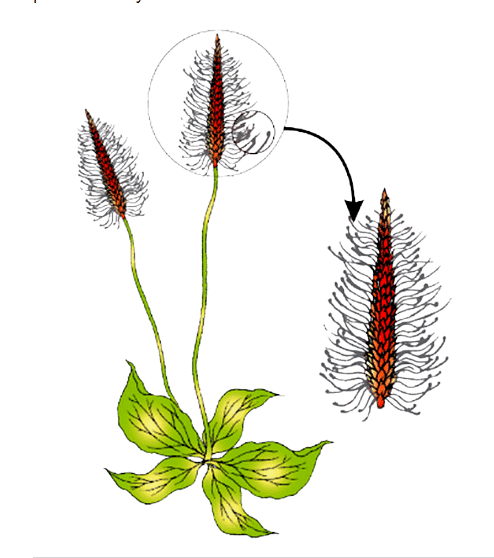
- a)Wind
- b)Water
- c)Bees
- d) Bats
Correct answer is option 'A'. Can you explain this answer?
The plant shown in the given diagram is most likely to be pollinated by:

a)
Wind
b)
Water
c)
Bees
d)
Bats

|
Top Rankers answered |
The plant in the diagram is likely pollinated by wind.
Here's why:
- The plant has feathery structures resembling stigmas, which catch pollen.
- The lack of showy petals or nectar suggests a reliance on wind.
- Wind-pollinated plants typically have lightweight pollen that can be carried by ai
Therefore, based on its characteristics, wind is the most likely pollination method for this plant.
- The plant has feathery structures resembling stigmas, which catch pollen.
- The lack of showy petals or nectar suggests a reliance on wind.
- Wind-pollinated plants typically have lightweight pollen that can be carried by ai
Therefore, based on its characteristics, wind is the most likely pollination method for this plant.
What is the mass percentage of carbon tetrachloride if 22g of benzene is dissolved in 122g of carbon tetrachloride?- a)84.72%
- b)15.28%
- c)50%
- d)44%
Correct answer is option 'A'. Can you explain this answer?
What is the mass percentage of carbon tetrachloride if 22g of benzene is dissolved in 122g of carbon tetrachloride?
a)
84.72%
b)
15.28%
c)
50%
d)
44%
|
|
Ananya Das answered |
Mass of solution = Mass of C6H6 + Mass of CCl4
= 22 + 122 = 144 g
Mass % of CCl4 = = 84.72%
= 84.72%
= 22 + 122 = 144 g
Mass % of CCl4 =
 = 84.72%
= 84.72%Concentration terms like mass percentage, ppm, mole fraction and molality do not depend on temperature. However, molarity is a function of temperature because- a)Volume depends on temperature and molarity involves volume
- b)Molarity involves non-volatile solute while all other terms involve volatile solute
- c)Number of moles of solute change with change in temperature
- d)Molarity is used for polar solvents only
Correct answer is option 'A'. Can you explain this answer?
Concentration terms like mass percentage, ppm, mole fraction and molality do not depend on temperature. However, molarity is a function of temperature because
a)
Volume depends on temperature and molarity involves volume
b)
Molarity involves non-volatile solute while all other terms involve volatile solute
c)
Number of moles of solute change with change in temperature
d)
Molarity is used for polar solvents only
|
|
Lavanya Menon answered |
Molarity of a solution is defined as the number of moles of solute dissolved per litre of solution. Since volume depends on temperature and changes with change in temperature, therefore, the molarity will also change with change in temperature. On the other hand, mass does not change with change in temperature, and therefore, concentration terms such as mass percentage, mole fraction and molality which do not involve volume are independent of temperature.
What will be the molality of a solution of glucose in water which is 10% w/W?- a)0.01 m
- b)0.617 m
- c)0.668 m
- d)1.623 m
Correct answer is option 'B'. Can you explain this answer?
What will be the molality of a solution of glucose in water which is 10% w/W?
a)
0.01 m
b)
0.617 m
c)
0.668 m
d)
1.623 m
|
|
Priya Menon answered |
Mass of the solution = 100g
Mass of glucose = 10g, Mass of water = 90 g
No. of moles of glucose = 10/180 = 0.0555mol
No. of moles of water = 90/18 = 5 mol
Molality = No. of moles of solute/Mass of solvent in kg
= 0.0555mol/0.0090kg = 0.617m
Mass of glucose = 10g, Mass of water = 90 g
No. of moles of glucose = 10/180 = 0.0555mol
No. of moles of water = 90/18 = 5 mol
Molality = No. of moles of solute/Mass of solvent in kg
= 0.0555mol/0.0090kg = 0.617m
Which of the following is/are not marine plant pollinated by water?- a)Vallisneria
- b)Hydrilla
- c)Zostera
- d)A and B
Correct answer is option 'D'. Can you explain this answer?
Which of the following is/are not marine plant pollinated by water?
a)
Vallisneria
b)
Hydrilla
c)
Zostera
d)
A and B
|
|
Jyoti Desai answered |
Understanding Marine Plant Pollination
Marine plants exhibit various modes of reproduction and pollination. Among these, some rely on water for their pollination processes, while others do not.
Marine Plants in the Question
- Vallisneria: This is a freshwater aquatic plant known for its unique method of reproduction. It has long, ribbon-like leaves and produces flowers that are pollinated by water currents. Although commonly found in water, it is not classified as a marine plant.
- Hydrilla: Like Vallisneria, Hydrilla is also a freshwater plant. It thrives in ponds and slow-moving waters. It reproduces both vegetatively and through flowering, but it does not have adaptations for marine environments.
- Zostera: This is a true marine plant, commonly known as eelgrass. Zostera is adapted to coastal marine environments and features flowers that are pollinated by water. It plays a crucial role in marine ecosystems, providing habitat and food for various marine organisms.
Correct Answer Explanation
The question asks which of the listed options is not marine plant-pollinated by water.
- Option D (A and B) is correct because both Vallisneria and Hydrilla are freshwater plants and do not inhabit marine environments. They do not participate in marine plant pollination.
- Zostera, on the other hand, is a marine plant that is indeed pollinated by water.
Conclusion
In summary, Vallisneria and Hydrilla are not marine plants and therefore do not fit the criteria of being marine plant pollinated by water, confirming that option D is the correct answer.
Marine plants exhibit various modes of reproduction and pollination. Among these, some rely on water for their pollination processes, while others do not.
Marine Plants in the Question
- Vallisneria: This is a freshwater aquatic plant known for its unique method of reproduction. It has long, ribbon-like leaves and produces flowers that are pollinated by water currents. Although commonly found in water, it is not classified as a marine plant.
- Hydrilla: Like Vallisneria, Hydrilla is also a freshwater plant. It thrives in ponds and slow-moving waters. It reproduces both vegetatively and through flowering, but it does not have adaptations for marine environments.
- Zostera: This is a true marine plant, commonly known as eelgrass. Zostera is adapted to coastal marine environments and features flowers that are pollinated by water. It plays a crucial role in marine ecosystems, providing habitat and food for various marine organisms.
Correct Answer Explanation
The question asks which of the listed options is not marine plant-pollinated by water.
- Option D (A and B) is correct because both Vallisneria and Hydrilla are freshwater plants and do not inhabit marine environments. They do not participate in marine plant pollination.
- Zostera, on the other hand, is a marine plant that is indeed pollinated by water.
Conclusion
In summary, Vallisneria and Hydrilla are not marine plants and therefore do not fit the criteria of being marine plant pollinated by water, confirming that option D is the correct answer.
What is the mass of urea required for making 2.5 kg of 0.25 molal aqueous solution?- a)37 g
- b)25 g
- c)125 g
- d)27.5 g
Correct answer is option 'A'. Can you explain this answer?
What is the mass of urea required for making 2.5 kg of 0.25 molal aqueous solution?
a)
37 g
b)
25 g
c)
125 g
d)
27.5 g
|
|
Anjali Sharma answered |
Mass of solvent = 1000 g
Molar mass of urea (NH2CONH2) = 60gmol−1
0.25 mole of urea = 0.25 × 60 = 15g
Total mass of solution = 100 + 15 = 1.015kg
1.015 kg of solution contain urea = 15g
2.5 kg of solution =
Molar mass of urea (NH2CONH2) = 60gmol−1
0.25 mole of urea = 0.25 × 60 = 15g
Total mass of solution = 100 + 15 = 1.015kg
1.015 kg of solution contain urea = 15g
2.5 kg of solution =

Two charges q and -3q are fixed on x-axis separated by distance d. Where should a third charge 2q be placed from A such that it will not experience any force?

- a)

- b)

- c)

- d)

Correct answer is option 'B'. Can you explain this answer?
Two charges q and -3q are fixed on x-axis separated by distance d. Where should a third charge 2q be placed from A such that it will not experience any force?


a)

b)

c)

d)

|
|
Lavanya Menon answered |

Let a charge 2q be placed at P, at a distance l from A where charge q is placed, as shown in figure.
The charge 2q will not experience any force, when force of repulsion on it due to q is balanced by force of attraction on it due to -3q at B where AB = d
or

(l + d)2 = 3l2 or 2l2 - 2ld - d2 = 0

If charge 2q is placed between A and B then

How does the relationship between the Yucca plant and its moth exemplify mutualism?- a)The Yucca plant provides food for the moth larvae, while the moth pollinates the plant.
- b)The Yucca plant provides nectar for the moth, and the moth provides water to the plant.
- c)The Yucca plant gives shelter to the moth, and the moth avoids pollinating the plant.
- d)The moth eats the flowers of the Yucca plant and does not assist in pollination.
Correct answer is option 'A'. Can you explain this answer?
a)
The Yucca plant provides food for the moth larvae, while the moth pollinates the plant.
b)
The Yucca plant provides nectar for the moth, and the moth provides water to the plant.
c)
The Yucca plant gives shelter to the moth, and the moth avoids pollinating the plant.
d)
The moth eats the flowers of the Yucca plant and does not assist in pollination.

|
Bs Academy answered |
In the mutualistic relationship between the Yucca plant and the moth, the moth deposits its eggs in the locule of the ovary of the flower, and in return, the plant gets pollinated. Both species depend on each other to complete their life cycles, with the moth benefiting from the plant for laying eggs and the plant benefiting from pollination.
What is the mole fraction of glucose in 10% w/W glucose solution?- a)0.01
- b)0.02
- c)0.03
- d)0.04
Correct answer is option 'A'. Can you explain this answer?
What is the mole fraction of glucose in 10% w/W glucose solution?
a)
0.01
b)
0.02
c)
0.03
d)
0.04
|
|
Geetika Shah answered |
No. of moles of glucose = 10/180 = 0.0555 mol
No. of moles of water = 90/18 = 5 mol
Number of moles of solution = 5.0555 mol
Mole fraction of glucose = No. of moles of glucose/No. of moles of solution = 0.0555/5.0555 = 0.01
No. of moles of water = 90/18 = 5 mol
Number of moles of solution = 5.0555 mol
Mole fraction of glucose = No. of moles of glucose/No. of moles of solution = 0.0555/5.0555 = 0.01
250mL of sodium carbonate solution contains 2.65g of Na2CO3. If 10mL of this solution is diluted to 500mL, the concentration of the diluted acid will be- a)0.01 M
- b)0.001 M
- c)0.05 M
- d)0.002 M
Correct answer is option 'D'. Can you explain this answer?
250mL of sodium carbonate solution contains 2.65g of Na2CO3. If 10mL of this solution is diluted to 500mL, the concentration of the diluted acid will be
a)
0.01 M
b)
0.001 M
c)
0.05 M
d)
0.002 M
|
|
Anjali Sharma answered |
Molarity of Na2CO3 solution
= 2.65/106 × 1000/250 = 0.1 M
10mL of this solution is diluted to 500mL
M1V1 = M2V2
0.1 × 10 = M2 × 500
⇒ M2 = 0.002M
= 2.65/106 × 1000/250 = 0.1 M
10mL of this solution is diluted to 500mL
M1V1 = M2V2
0.1 × 10 = M2 × 500
⇒ M2 = 0.002M
The density of a solution prepared by dissolving 120g of urea (mol. mass = 60u) in 1000g of water is 1.15g/mL. The molarity of this solution is- a)1.78M
- b)1.02M
- c)2.05M
- d)0.50M
Correct answer is option 'C'. Can you explain this answer?
The density of a solution prepared by dissolving 120g of urea (mol. mass = 60u) in 1000g of water is 1.15g/mL. The molarity of this solution is
a)
1.78M
b)
1.02M
c)
2.05M
d)
0.50M
|
|
Anjali Sharma answered |
Mass of solute taken = 120g
Molecular mass of solute = 60u
Mass of solvent = 1000g
Density of solution = 1.15g/mL
Total mass of solution = 1000 + 120 = 1120g

Molecular mass of solute = 60u
Mass of solvent = 1000g
Density of solution = 1.15g/mL
Total mass of solution = 1000 + 120 = 1120g
Calculate the percentage composition of a solution obtained by mixing 300 g of a 20% and 200 g of a 30% solution by weight.
- a)50%
- b)28%
- c)64%
- d)24%
Correct answer is option 'D'. Can you explain this answer?
Calculate the percentage composition of a solution obtained by mixing 300 g of a 20% and 200 g of a 30% solution by weight.
a)
50%
b)
28%
c)
64%
d)
24%
|
|
Gaurav Kumar answered |
Mass of solute is obtained by multiplying % weight with mass of solvent and obtaining an answer divided by 100.
Mass of solute in 200g of 30% solution can be obtained as follows:
30% by weight indicates 30g of solute is present in 100g of solvent so 60g of solute will be present in 200g of solution.
20% by weight indicates 20g of solute is present in 100g of solvent so 60g of solute will be present in 300g of solution
So on mixing these both solutions, mass of solute is 60g +60g =120g
Mass of solution on mixing is 200g +300g =500g
Percent of solute can be obtained as follows:

Mass of solute in 200g of 30% solution can be obtained as follows:
30% by weight indicates 30g of solute is present in 100g of solvent so 60g of solute will be present in 200g of solution.
20% by weight indicates 20g of solute is present in 100g of solvent so 60g of solute will be present in 300g of solution
So on mixing these both solutions, mass of solute is 60g +60g =120g
Mass of solution on mixing is 200g +300g =500g
Percent of solute can be obtained as follows:

24% percentage of solute in the final solution.
Wind-pollinated flowers are characterized by the following, except- a)Large, often-feathery stigma
- b)Light and non-sticky pollen grains
- c)Well-exposed stamens
- d)Many ovules in each ovary
Correct answer is option 'D'. Can you explain this answer?
Wind-pollinated flowers are characterized by the following, except
a)
Large, often-feathery stigma
b)
Light and non-sticky pollen grains
c)
Well-exposed stamens
d)
Many ovules in each ovary

|
Ambition Institute answered |
Wind-pollinated flowers are characterized by traits facilitating pollination by wind.
The exception is D: Many ovules in each ovary. its actually Wind pollinated flowers often have a single ovule in each ovary and numerous flowers packed into an inflorescence; a familiar example is the corn cob – the tassels you see are nothing but the stigma and style which wave in the wind to trap pollen grains.Here's why:
- Wind-pollinated flowers typically have:
- Large, often-feathery stigma to catch airborne pollen effectively.
- Light and non-sticky pollen grains that can be carried by the wind.
- Well-exposed stamens for easy dispersal of pollen.
- Having many ovules in each ovary is not a characteristic related to wind pollination; it's more about seed development after pollination.
Topic in NCERT: Wind Pollination in Flowering Plants
Line in NCERT: "Wind-pollinated flowers often have a single ovule in each ovary and numerous flowers packed into an inflorescence."
The exception is D: Many ovules in each ovary. its actually Wind pollinated flowers often have a single ovule in each ovary and numerous flowers packed into an inflorescence; a familiar example is the corn cob – the tassels you see are nothing but the stigma and style which wave in the wind to trap pollen grains.Here's why:
- Wind-pollinated flowers typically have:
- Large, often-feathery stigma to catch airborne pollen effectively.
- Light and non-sticky pollen grains that can be carried by the wind.
- Well-exposed stamens for easy dispersal of pollen.
- Having many ovules in each ovary is not a characteristic related to wind pollination; it's more about seed development after pollination.
Topic in NCERT: Wind Pollination in Flowering Plants
Line in NCERT: "Wind-pollinated flowers often have a single ovule in each ovary and numerous flowers packed into an inflorescence."
From among the situations given below, choose the one that prevents both autogamy and geitonogamy.- a)Monoecious plant bearing unisexual flowers
- b)Monoecious plant with bisexual flowers
- c)Dioecious plant bearing only male or female flowers
- d)Dioecious plant with bisexual flowers
Correct answer is option 'C'. Can you explain this answer?
From among the situations given below, choose the one that prevents both autogamy and geitonogamy.
a)
Monoecious plant bearing unisexual flowers
b)
Monoecious plant with bisexual flowers
c)
Dioecious plant bearing only male or female flowers
d)
Dioecious plant with bisexual flowers
|
|
Diya Khanna answered |
Explanation:
Monoecious vs. Dioecious Plants:
- Monoecious plants have both male and female reproductive structures on the same plant.
- Dioecious plants have separate male and female plants.
Autogamy and Geitonogamy:
- Autogamy is the self-pollination of a flower.
- Geitonogamy is the pollination of a flower with pollen from another flower on the same plant.
Preventing Autogamy and Geitonogamy:
- In a monoecious plant bearing unisexual flowers (option a), although there are separate male and female flowers on the same plant, autogamy can still occur if the pollen from the male flower fertilizes the female flower on the same plant.
- In a monoecious plant with bisexual flowers (option b), both male and female reproductive structures are present in the same flower, which can lead to both autogamy and geitonogamy.
- In a dioecious plant bearing only male or female flowers (option c), since male and female flowers are present on separate plants, both autogamy and geitonogamy are prevented. This is because pollen from a male flower on one plant cannot fertilize a female flower on the same plant, thus ensuring cross-pollination between different plants.
- In a dioecious plant with bisexual flowers (option d), although male and female flowers are present on separate plants, the presence of bisexual flowers can still lead to geitonogamy if pollen from a flower on one plant fertilizes a flower on another plant of the same species.
Therefore, option c (Dioecious plant bearing only male or female flowers) is the situation that prevents both autogamy and geitonogamy.
Monoecious vs. Dioecious Plants:
- Monoecious plants have both male and female reproductive structures on the same plant.
- Dioecious plants have separate male and female plants.
Autogamy and Geitonogamy:
- Autogamy is the self-pollination of a flower.
- Geitonogamy is the pollination of a flower with pollen from another flower on the same plant.
Preventing Autogamy and Geitonogamy:
- In a monoecious plant bearing unisexual flowers (option a), although there are separate male and female flowers on the same plant, autogamy can still occur if the pollen from the male flower fertilizes the female flower on the same plant.
- In a monoecious plant with bisexual flowers (option b), both male and female reproductive structures are present in the same flower, which can lead to both autogamy and geitonogamy.
- In a dioecious plant bearing only male or female flowers (option c), since male and female flowers are present on separate plants, both autogamy and geitonogamy are prevented. This is because pollen from a male flower on one plant cannot fertilize a female flower on the same plant, thus ensuring cross-pollination between different plants.
- In a dioecious plant with bisexual flowers (option d), although male and female flowers are present on separate plants, the presence of bisexual flowers can still lead to geitonogamy if pollen from a flower on one plant fertilizes a flower on another plant of the same species.
Therefore, option c (Dioecious plant bearing only male or female flowers) is the situation that prevents both autogamy and geitonogamy.
Which of the following is true regarding insect-pollinated flowers?- a)Insect-pollinated flowers are typically small, colorless, and lack fragrance.
- b)Insect-pollinated flowers are large, colorful, and fragrant to attract animals.
- c)Insect-pollinated flowers do not secrete nectar or pollen.
- d)Insect-pollinated flowers provide no reward for animal visitors.
Correct answer is option 'B'. Can you explain this answer?
a)
Insect-pollinated flowers are typically small, colorless, and lack fragrance.
b)
Insect-pollinated flowers are large, colorful, and fragrant to attract animals.
c)
Insect-pollinated flowers do not secrete nectar or pollen.
d)
Insect-pollinated flowers provide no reward for animal visitors.

|
Ambition Institute answered |
Insect-pollinated flowers are large, colorful, and fragrant, which help attract animals such as insects. They secrete nectar and pollen as rewards for the animals, which in turn assist in pollination. Flowers pollinated by flies and beetles may also secrete foul odors to attract those specific animals.
Three charges of equal magnitude q is placed at the vertices of an equilateral triangle of side l.The force on charge Q placed at the centroid of the triangle is - a)

- b)

- c)

- d)zero
Correct answer is option 'D'. Can you explain this answer?
Three charges of equal magnitude q is placed at the vertices of an equilateral triangle of side l.The force on charge Q placed at the centroid of the triangle is
a)

b)

c)

d)
zero
|
|
Hansa Sharma answered |
As shown in figured raw AD ⊥ BC.
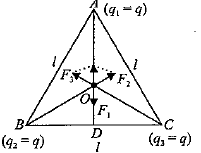

Distance AO of the centroid O from A

∴ Force on Q at O due to charge q1 = q at A,

Similarly, force on O due to charge q2 = q at B
 along BO and force on Q due to charge q3 = q at c
along BO and force on Q due to charge q3 = q at c

Angle between forces F2 and F3 = 120°
By parallelogram law, resultant of along OA
along OA
∴ Total force on Q =

Distance AO of the centroid O from A

∴ Force on Q at O due to charge q1 = q at A,

Similarly, force on O due to charge q2 = q at B
 along BO and force on Q due to charge q3 = q at c
along BO and force on Q due to charge q3 = q at c
Angle between forces F2 and F3 = 120°
By parallelogram law, resultant of
 along OA
along OA∴ Total force on Q =

Consider the charges q, q and -q placed at the vertices of an equilateral triangle of each side l. The sum of forces acting on each charge is- a)

- b)

- c)

- d)zero
Correct answer is option 'D'. Can you explain this answer?
Consider the charges q, q and -q placed at the vertices of an equilateral triangle of each side l. The sum of forces acting on each charge is
a)

b)

c)

d)
zero
|
|
Dev Patel answered |
From diagram, force on q1(= q) at A,
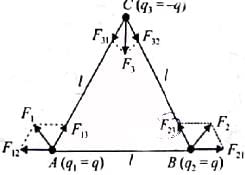

where is the unit vector along BC
is the unit vector along BC
Force on
(where is the unit vector along AC)
is the unit vector along AC)
Force on q3(= -q) at C,

where unit vector along the direction bisecting ∠BCA
unit vector along the direction bisecting ∠BCA



where
 is the unit vector along BC
is the unit vector along BC Force on

(where
 is the unit vector along AC)
is the unit vector along AC)Force on q3(= -q) at C,

where
 unit vector along the direction bisecting ∠BCA
unit vector along the direction bisecting ∠BCA
A charge Q is placed at the centre of the line joining two point charges +q and +q as shown in figure. The ratio of charges Q and q is

- a)4
- b)1/4
- c)-4
- d)-1/4
Correct answer is option 'D'. Can you explain this answer?
A charge Q is placed at the centre of the line joining two point charges +q and +q as shown in figure. The ratio of charges Q and q is


a)
4
b)
1/4
c)
-4
d)
-1/4
|
|
Preeti Iyer answered |
For the system to be in equilibrium, net force on q = 0 or 
or Q = (-q)/4 or Q/q = -(1/4)

or Q = (-q)/4 or Q/q = -(1/4)
The diagram of NCERT given below shows two types of flowers in a certain plant: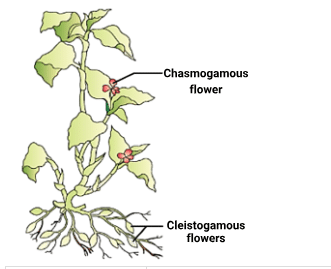 Statement I:Cleistogamous flowers have an advantage and a disadvantage over chasmogamous flowers.Statement II:Seed set is assured even in the absence of pollinators but the amount of genetic variations is less in cleistogamous flowers when compared to the chasmogamous flowers.
Statement I:Cleistogamous flowers have an advantage and a disadvantage over chasmogamous flowers.Statement II:Seed set is assured even in the absence of pollinators but the amount of genetic variations is less in cleistogamous flowers when compared to the chasmogamous flowers.- a)Statement I is correct; Statement II is correct but Statement II does not explain Statement I.
- b)Statement I is correct but Statement II is not correct.
- c)Both Statement I and Statement II are not correct.
- d)Statement I is correct; Statement II is correct and Statement II explains Statement I.
Correct answer is option 'D'. Can you explain this answer?
The diagram of NCERT given below shows two types of flowers in a certain plant:

Statement I:Cleistogamous flowers have an advantage and a disadvantage over chasmogamous flowers.
Statement II:Seed set is assured even in the absence of pollinators but the amount of genetic variations is less in cleistogamous flowers when compared to the chasmogamous flowers.
a)
Statement I is correct; Statement II is correct but Statement II does not explain Statement I.
b)
Statement I is correct but Statement II is not correct.
c)
Both Statement I and Statement II are not correct.
d)
Statement I is correct; Statement II is correct and Statement II explains Statement I.

|
Lead Academy answered |
The correct answer is: D: Statement I is correct; Statement II is correct and Statement II explains Statement I.
- Explanation:
- Cleistogamous flowers have an advantage and a disadvantage over chasmogamous flowers.
- Seed set is assured even without pollinators, but genetic variations are less in cleistogamous compared to chasmogamous flowers.
- This means that cleistogamous flowers ensure seed production without external help, but with limited genetic diversity, which is explained by the second statement.
- Explanation:
- Cleistogamous flowers have an advantage and a disadvantage over chasmogamous flowers.
- Seed set is assured even without pollinators, but genetic variations are less in cleistogamous compared to chasmogamous flowers.
- This means that cleistogamous flowers ensure seed production without external help, but with limited genetic diversity, which is explained by the second statement.
The diagram shows: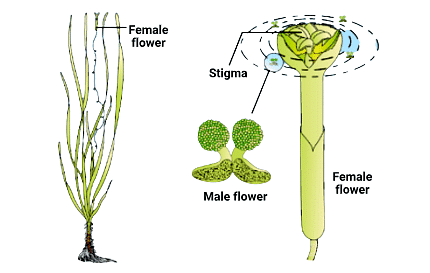
- a)Pollination by water in Zostera
- b)Pollination by wind in Water hyacinth
- c) Pollination by the wind in Water lily
- d)Pollination by water in Vallisneria
Correct answer is option 'D'. Can you explain this answer?
The diagram shows:

a)
Pollination by water in Zostera
b)
Pollination by wind in Water hyacinth
c)
Pollination by the wind in Water lily
d)
Pollination by water in Vallisneria

|
Top Rankers answered |
The correct answer is D: Pollination by water in Vallisneria.
- Vallisneria is a submerged aquatic plant that relies on water for pollination.
- It has separate male and female flowers on different plants.
- Male flowers detach and float on the water surface, releasing pollen.
- The pollen is then carried by water currents to reach the female flowers for pollination.
- This method ensures successful fertilization in underwater environments.
- Vallisneria is a submerged aquatic plant that relies on water for pollination.
- It has separate male and female flowers on different plants.
- Male flowers detach and float on the water surface, releasing pollen.
- The pollen is then carried by water currents to reach the female flowers for pollination.
- This method ensures successful fertilization in underwater environments.
Chapter doubts & questions for April Week 2 - Weekly Tests for NEET Preparation 2025 is part of NEET exam preparation. The chapters have been prepared according to the NEET exam syllabus. The Chapter doubts & questions, notes, tests & MCQs are made for NEET 2025 Exam. Find important definitions, questions, notes, meanings, examples, exercises, MCQs and online tests here.
Chapter doubts & questions of April Week 2 - Weekly Tests for NEET Preparation in English & Hindi are available as part of NEET exam.
Download more important topics, notes, lectures and mock test series for NEET Exam by signing up for free.
Related NEET Content

Contact Support
Our team is online on weekdays between 10 AM - 7 PM
Typical reply within 3 hours
|
Free Exam Preparation
at your Fingertips!
Access Free Study Material - Test Series, Structured Courses, Free Videos & Study Notes and Prepare for Your Exam With Ease

 Join the 10M+ students on EduRev
Join the 10M+ students on EduRev
|

|
Create your account for free
OR
Forgot Password
OR
Signup to see your scores
go up
within 7 days!
within 7 days!
Takes less than 10 seconds to signup












